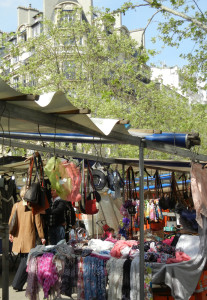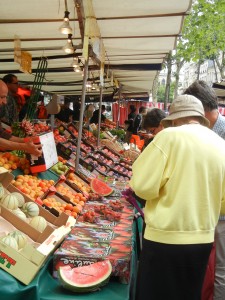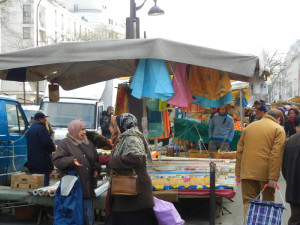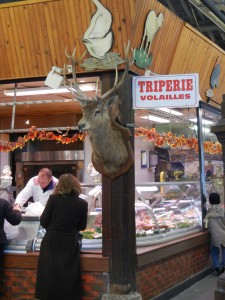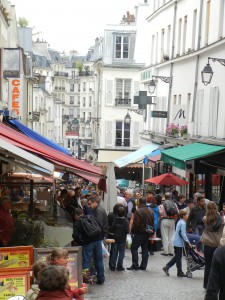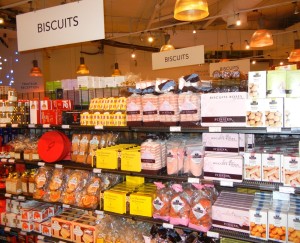Markets in Paris can be sorted into two broad groups: food and non-food. This post describes different kinds of food markets you can find in Paris. Other posts delve into a variety of other classic Parisian markets, such as flea markets, brocantes, and more. A few points to keep in mind:
* Parisian markets defy tidy categories. At food markets, one also finds clothing, flowers, jewelry, kitchen items and more. And non-food markets often have stalls or cafés selling food.
* Food markets in Paris are not “farmers’ markets” where growers sell directly to consumers. Many vendors are middlemen. Don’t let that deter you. They are very good at what they do. If you prefer to buy directly from producteurs, read this for tips on how to identify them.
* Every neighborhood in Paris has a smattering of Monoprix, Franprix and other chain stores, along with green grocers in permanent locations. They have merits, but they are not the food markets in Paris that interest me. I’m referring to markets, often erected and deconstructed the same day, where numerous vendors come together to serve the neighborhood. Most of these markets have been around for centuries. They are a vital part of Parisian history and culture.
What are the different types of food markets in Paris?
Open-Air Markets:
Each operates on its own schedule and is open only certain days of the week. With over 70 open-air markets throughout Paris, there are plenty to choose from every day except Monday when most are closed. Check the list of open-air food markets on the Mairie de Paris website. Or grab a copy of Dixon Long’s and my book Markets of Paris, 2nd ed. for essential information about all the markets, organized by neighborhood.
Vendors set up stalls in the morning and tear them down by mid-afternoon. Each outdoor market has its own personality which reflects the tastes, traditions, and incomes of that neighborhood’s residents. Some popular ones are Marché Raspail (a regular version and a Sunday organic), Marché Président Wilson, Marché Bastille, and Marché Place Monge. Markets in slightly farther arrondissements, such as Belleville and Barbès, are rising in popularity. They serve a higher density of immigrants. Those markets tend to be less expensive and very vibrant. Paris has three weekly organic markets: Sunday’s Raspail market, and on Saturdays at Batignolles and also Brancusi.
Covered Markets:
There are ten “marchés couverts” in Paris. They are generally open Tuesday through Sunday. Some are located in Baltard-style buildings, which might interest architecture and history buffs.
Covered markets are a good choice for rainy days but a terrific option in dry weather too. Marché Enfants-Rouges in the Marais neighborhood along rue de Bretagne is the city’s oldest. This and other covered markets in Paris are well worth a visit.
Street Markets:
I think of Parisian street markets as “double-density” shopping opportunities. Vendors set up on sidewalks, and behind them is a row of shops. Some outdoor vendors also own the shop behind them. More often, they’re independent. A few examples of Parisian street markets are rue Montorgueil, rue Cler, rue Mouffetard, and rue d’Aligre. There are about a dozen pedestrian market streets in Paris.
If one loosens the definition to streets that allow vehicles but offer many food shops–such as rue des Martyrs– there are even more.
Gourmet Food Halls:
Two gourmet food emporiums stand out in Paris. La Grande Épicerie, part of Bon Marché department store, is the best food hall on the Left Bank. It has recently undergone a renovation and has a new look.
Its rough equivalent on the Right Bank is Galeries Lafayette Gourmet Food Hall. Both sell a mind-boggling assortment of prepared, packaged, and fresh foods. They’re excellent stops for food-related gifts too.
As you can see, there are many options from which to choose. My advice is to sample all the different types of food markets in Paris so that you experience the full breadth.
I’ll be writing about “Tips for Shopping at the Paris Food Markets” in a forthcoming post. Stay tuned!

